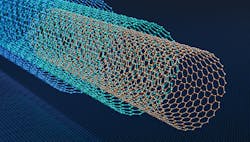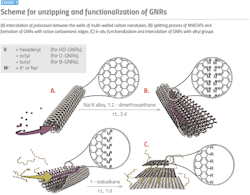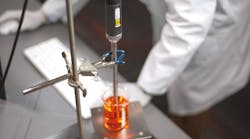Many nanoparticles, including graphene nanoribbons, have been developed and studied over the past few decades. Much excitement has been generated around their potential use as both therapeutic and diagnostic tools.
Numerous nanoparticle formulations for medicinal and diagnostic purposes have been developed because of recent breakthroughs in nanotechnology. Using diagnostic nanoparticles and other graphene-derived nanostructures, researchers have been able to visualize pathologies and advance knowledge of crucial (patho-)physiological concepts underlying various diseases and disease treatments.
A wave of new research is exploring how the industry can utilize graphene nanoribbons (GNRs) in drug delivery and beyond to allow for more precise therapeutic treatments.
The promise of graphene nanoribbons
The poster child of nanotechnology is undoubtedly graphene: a two-dimensional hexagonal lattice made of sp2-hybridized carbon atoms. Graphene exhibits several exceptional properties: It is the strongest material ever tested and exhibits extraordinarily high thermal conductivity and vanishingly low electrical conductivity. Graphene forms the basis of a wide variety of graphene-derived nanostructures that have already been used in countless applications throughout science, technology and engineering. Graphene and graphene-derived nanostructures are the subject of considerable scientific research to develop novel technological solutions.
Strips of graphene with widths of the order of tens of nanometers are known as graphene nanoribbons. Inheriting the properties of graphene sheets but exhibiting electron confinement properties across its short axis, the properties of graphene nanoribbons are no less exceptional. GNRs show promise in a variety of applications and have generated attention from researchers in domains including chemistry, physics, materials science and medicine. These fields are interested in graphene nanoribbons due to their high aspect ratio, electronic properties, conductivity, and propensity for functionalization.
Graphene nanoribbons have already been used in several applications, including bioimaging, DNA sequencing, batteries, conductive films, polymer composites, sensors, and energy conversion or storage devices.
The electrical and mechanical characteristics of GNRs are exceptional. Mechanical, chemical, photo- and acoustic sensors, instruments for the direct sequencing of biological macromolecules including DNA, gene and drug delivery systems, and tissue engineering are among the application fields.
Graphene nanoribbons as drug delivery agents
Researchers have demonstrated the viability of pH-controlled drug uptake and delivery using graphene oxide by creating self-assembling supramolecular hydrogels from graphene oxide and metformin hydrochloride, an important drug for diabetes treatment. The resulting hydrogels showed increased drug-release rates in acidic media, suggesting that similar approaches could be used for controlled drug release in the stomach.
Much research into graphene nanoribbon or graphene-based drug delivery technologies focuses on cancer treatment. In these roles, graphene-based solutions provide the opportunity to deliver more targeted cancer treatments, thus decreasing the systemic toxicity associated with conventional cancer treatment drugs. GNRs have a large surface area, which lends itself well to functionalization with chemical groups or physisorbed moieties. Oxidized nanoribbons (oGNR) and reduced graphene nanoribbons (rGNR) are envisaged as unique drug delivery agents in cancer and tumor therapy, with early research demonstrating the potential of these materials in delivering cancer treatment drugs to tumor sites.
Graphene nanoribbons have also been utilized as mediators in photothermal therapy for cancer treatment, in which non-ionizing radiation (usually infrared) is used to kill cancer cells. By functionalizing reduced graphene oxide nanoribbons with polyethylene glycol (PEG), researchers could attach markers to human glioblastoma cells for selective fluorescence imaging. This resulted in high performance in subsequent near-infrared photothermal therapy. In another report, researchers used phospholipid-PEG-modified graphene oxide nanoribbons to treat glioma cells in combination with chemotherapy and photothermal therapy. The results showed that drug chemotherapy and near-infrared hyperthermia could function synergistically, opening up new avenues of research for novel cancer treatments.
Beyond therapeutics
Researchers have also been exploring applications of graphene nanoribbons across various sectors of biomedicine.
Bioimaging
Carbon nanomaterials can cross cellular membranes and exhibit enhanced Raman scattering, strong near-infrared absorption, high photoluminescence yield, and photoacoustic response. Coupled with a huge potential for functionalization and strong biocompatibility, these materials — including graphene oxide, graphene nanoribbons, and carbon nanotubes — show tremendous promise as contrast agents in imaging applications. It is possible to improve existing contrast agents with graphene and its derivatives and create whole new probes and agents for biomedical imaging. These promise to improve our ability to monitor processes in living cells, tissues, or even entire bodies using a variety of approaches.
Neurophysiological rehabilitation
Recent research from the group demonstrates that nontoxic polyethylene glycol graphene nanoribbons can create a favorable microenvironment for spinal cord healing following injury. PEG-Graphene nanoribbons’ main structural elements provide a microenvironment that is receptive to healing. The composite material fills the space left by severed axons to create a nanoscaffold that can facilitate the transmission of neuronal signals across the lesion while allowing growth along the framework.
The Tour group has already demonstrated in five rats that applying 0.5 mL of a 1% PEG-Graphene nanoribbons solution in PEG 600 at C5 vertebra following total cervical transection led to a 24-hour restoration of about 30% of the pre-surgery somatosensory evoked potentials (SSEP) amplitude, a measure of brain and spinal cord response. Within two weeks following surgery, one animal without SSEP measures regained use of its forelimbs and hindlimbs, scoring 19 out of 21 by week three on the
Basso, Beattie, and Bresnahan (BBB) motility scale.
Biosensing
The field of biosensing involves the detection, identification and quantification of biological substances. Biosensors are particularly important in bioanalytical chemistry, where they can shed light on the interactions that occur in complex biological processes.
The unique electronic properties of graphene oxide nanoribbons present opportunities for the development of optical biosensing technologies. Optical biosensors use light to probe molecular interactions and have numerous applications in clinical diagnostics, drug discovery, food process control and environmental monitoring.
In addition to high conductivity and excellent electrochemical stability, graphene nanoribbons have good light transmittance, making them ideal candidates for optical biosensor elements. Graphene nanomaterials have brought a new surge of interest in optical biosensor research, with GNR hybrid materials using graphene nanobelts (or reduced graphene oxide nanobelts) exhibiting excellent optoelectronic properties that can be used in biosensing applications.
Research in 2015 showed that graphene nanoribbons coated with a cobalt coordination polymer could provide a wide linear range and low detection limit in H202 sensing. Other approaches include using modified graphene nanoribbons as signal amplifiers for photoelectrochemical biosensors driven by natural light.
Widespread potential
Due to their amphiphilic properties, graphene-oxide nanoribbons — the oxygenated derivative of graphene nanoribbons — provide numerous opportunities in the field of biomedicine. For cutting-edge biomedical applications, they can be modified noncovalently and covalently to provide a huge range of functionality in diagnostic and therapeutic applications.
From sensitive biosensing to precisely targeted drug delivery, the potential applications of graphene nanoribbons (and other graphene-derived nanostructures) are widespread and promise to have a significant impact throughout life sciences.







